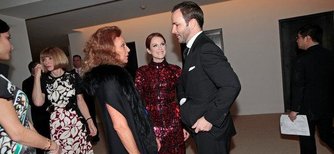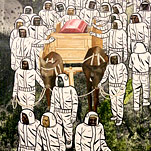Margaret Reid Boyer’s photographs are arresting explorations of the evidence of family life and privilege: the domestic litter on a white marble bathroom sink; a patchwork of bright green sod in an expansive, lozenge-shaped backyard; a teenage girl with an inscrutable expression, a Parcheesi game laid out before her on an Indian print-covered table flanked by yellow Eames chairs.
It’s That Brownstone. Again.

The Brooklyn brownstones of Merele Williams-Adkins, left, and Margaret Reid Boyerare are sought by location scouts and used for photo shoots. More Photos »
By PENELOPE GREEN
Published: November 13, 2013
Multimedia
Follow Home on Twitter
Connect with us at @NYTimesHome for articles and slide shows on interior design and life at home.
The photographer Sally Mann is a touchstone, to be sure, as is Tina Barney. For Ms. Reid Boyer, who is 48 and the mother of two sets of twins, is limning her own experiences by depicting her children, home and possessions in tense and vivid images. She is intent on surfaces, and on what lies beneath.
Yet beyond the universal narratives the photographs suggest, the domestic landscapes are familiar in another way, as they display the accouterments and landmarks of Ms. Reid Boyer’s neighborhood, Brooklyn Heights, and its stately brownstones. That habitat, with its marble fireplaces and soaring ceilings — and similar ones found in surrounding neighborhoods like Cobble Hill, Park Slope and Boerum Hill — is on track to become the aspirational space of the year.
The Brooklyn brownstone has been fetishized in so many catalogs, ads and television shows, including Design Within Reach, Target and Lena Dunham’s “Girls,” to name a fraction, that location scouts like Andrea Raisfeld of Bedford, N.Y., say it has become the bulk of their business. After rattling off the addresses of seven of her “cash cows,” as she described her most-requested Brooklyn brownstones, Ms. Raisfeld, who has 100 Brooklyn properties in her portfolio, recalled how in the 1990s it was Westport, Conn. — Martha Stewart country — that beckoned.
Its ubiquity as an idealized backdrop for the chattering classes casts this part of Brooklyn as a kind of modern Cheever country: here are all the trappings of the suburban good life, and the attendant complexities. This is a Brooklyn that would be all but unrecognizable to 1960s-era authors like Paula Fox, whose novel “Desperate Characters” used the tension of the neighborhood at that time to explore the cracks in a marriage and a society. Novelists, to be sure, have been playing in this sandbox for decades, from Paule Marshall to Paul Auster, Jonathan Lethem to Amy Sohn.
But this year, it is the image-makers’ turn. In “One Man’s Trash,” a surprisingly poignant episode of “Girls” from last season, Hannah has a fleeting collision with a handsome, divorced Brooklyn brownstone owner played by Patrick Wilson. Standing slack-jawed in his high-end kitchen (with the requisite marble fireplace and Sub-Zero refrigerator), Hannah blurts out, “I feel like I’m in a Nancy Meyers movie,” referring to another chronicler of real estate porn.
His terse response to Hannah’s awe lets you know that his wife has left him, that they renovated the brownstone together and that its magazine-ready comeliness is now a hollow container for broken dreams. It is a reflection of how the geography of aspiration has shifted: if “Girls” were set in the last decade, this man would be living in a TriBeCa loft.
Ms. Reid Boyer and Ms. Dunham are not the only documentarians training a sharp lens on this part of Brooklyn. Laura Karetzky, who just happens to live around the corner from Ms. Reid Boyer, is a painter of minute moments, and though each is framed like an accidental snapshot and some are as small as a paperback book, those in the know can recognize the settings: In the lobby of a prewar apartment building on Willow Street, fractious neighbors square off at a co-op meeting; in a brownstone’s backyard, her daughters stand tensely under a window with a torn screen; in a pew at St. Ann’s church, a couple whisper. Like Ms. Reid Boyer, she is examining her milieu through the gendered perspective of a woman at midlife. Ms. Karetzky is 48 and divorced, sharing custody of her two daughters with her banker ex-husband.
The stereotype of “the Brooklyn artist” usually locates him or her in Williamsburg or Bushwick. But as Elizabeth Ferrer, director of contemporary art at BRIC, an arts organization and gallery on Fulton Street, noted: “There are artists in these leafy neighborhoods, too. There are artists who are affluent. It’s not all ‘La Vie Bohème.’ Not all of them are struggling, which is not to say they aren’t serious artists. They just don’t meet the stereotype.”












